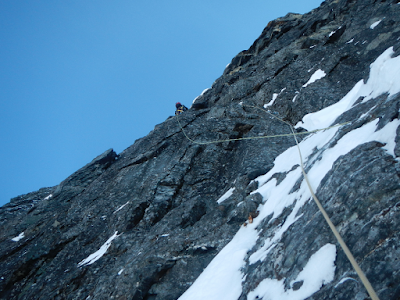Thoughts about ropes and how some factors can directly change the performance
The presence of water or ice on our climbing ropes produces important modifications in their performance, maybe more than we think?!
The dynamic resistance of the ropes down to 30 % of the initial value - when they are soaked with water. Independent of if they new or used, normal or waterproofed.
After soaking in water a rope becomes 4-5% longer, which can be correlated to the 5-10% increase of the impact force .
The negative effects of water on the dynamic performance of ropes are remarkable even in case of a brief soaking time, even after being splashed under a shower.
This behaviour seems to be due to the interaction of water with the crystal structure of the nylon macromolecule (according to literature).
Such behaviour lasts as long as the rope is wet, but after drying - in a cool, airy and shady place, as recommended - the rope recovers almost completely its original dynamic performance, even after various soaking/drying cycles.
Depending on the drying grade (normal or thorough) the rope can become shorter by 4% to 8%, which seems to be correlated to the decrease by 6-12% of the impact force on a first fall test.
Even in the case of soaked and frozen ropes the dynamic resistance decreases, but less than in wet ropes.
With this in mind a used rope in good conditions, which still could hold 4-5 falls in the UIAA test with a Dodero machine when dry, might only hold 1 or 2 falls when soaked. Like after a sudden rain fall, as often occurs in the mountains. And which also make the risk of a fall bigger since the rock would be wet, if it's not seriously overhanging!
This may not be too much of a serious problem when sportclimbing, where falls are usually less dangerous and it takes little time to be lowered, pull the rope down and go home.
But mountaineers must demand the maximum security from their rope, even when wet, since it might snap on a rough edge during a fall.
This risk is lower when the rope is in good condition.
The problem could also be less critical when climbing a glacier or an ice-fall, because the ropes are frozen, but even in this case the temperature is very important.
Since if it is goes over -0° C, the rope returns from frozen to being wet!
Not taken in the fact that a wet/frozen rope make it seriously difficult to handle. But that is an other story...
So, in conclusion, it seems like a good idea to keep a close eye on the condition of the rope. Not just before and after the climbing day out.
And maybe consider changing our ropes more often as well!?
// when you change the way you look at things, the things you look at, change.





No comments:
Post a Comment